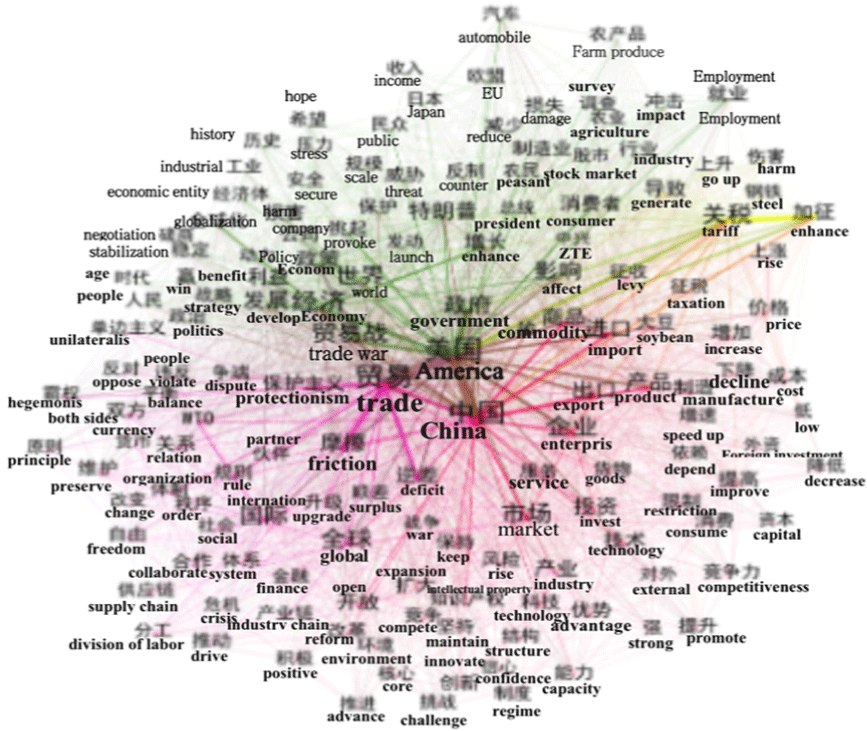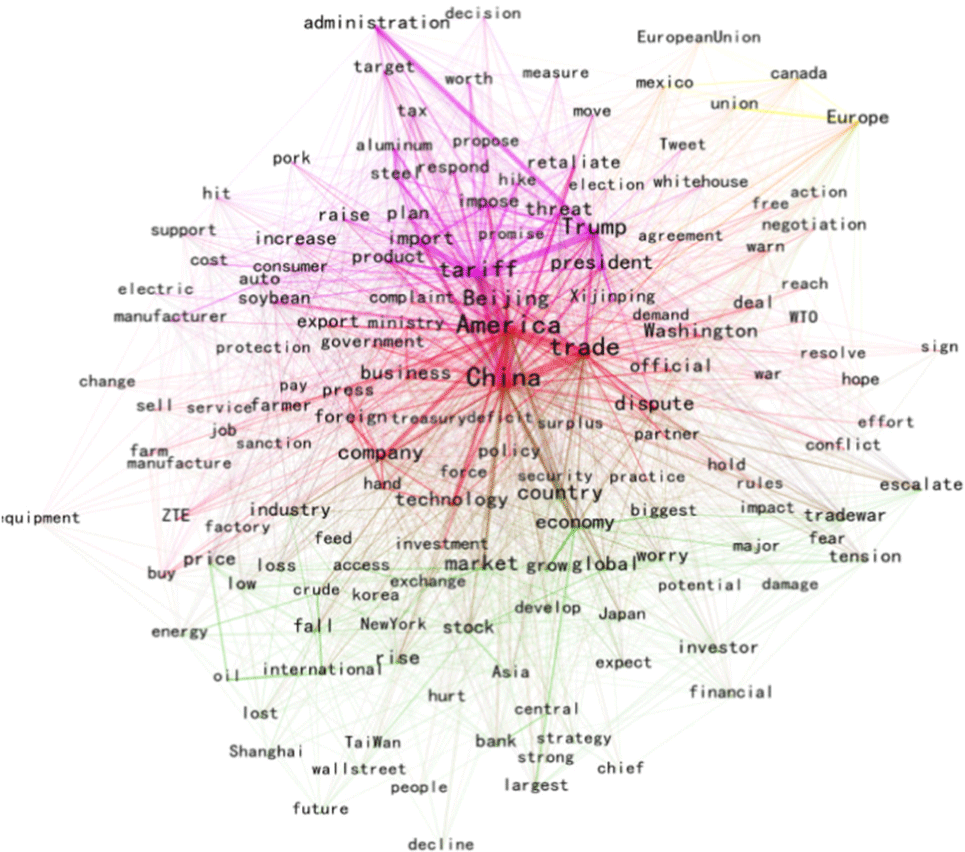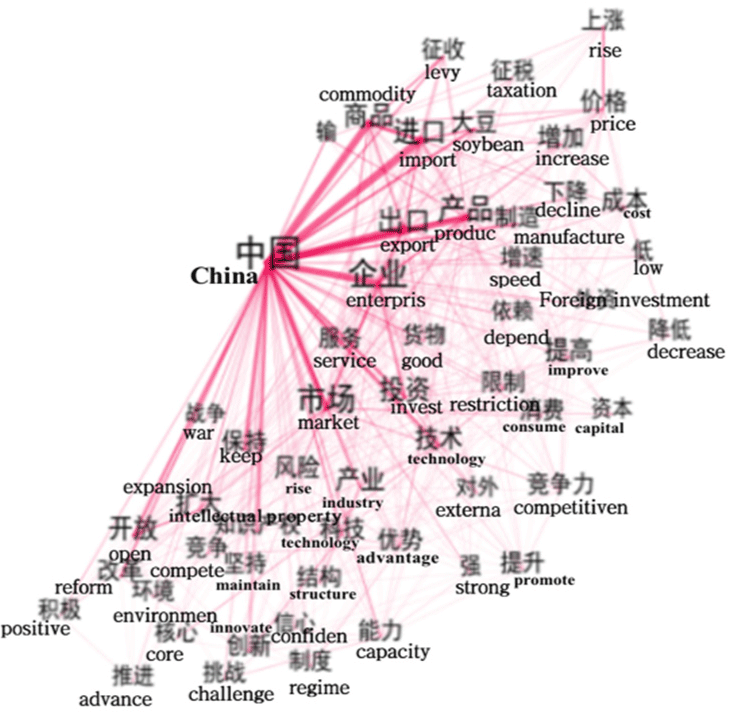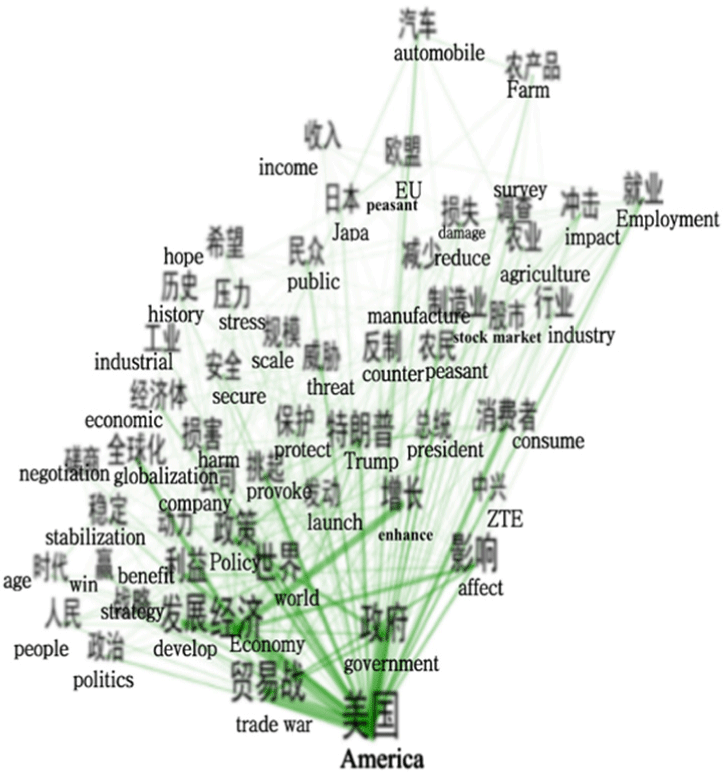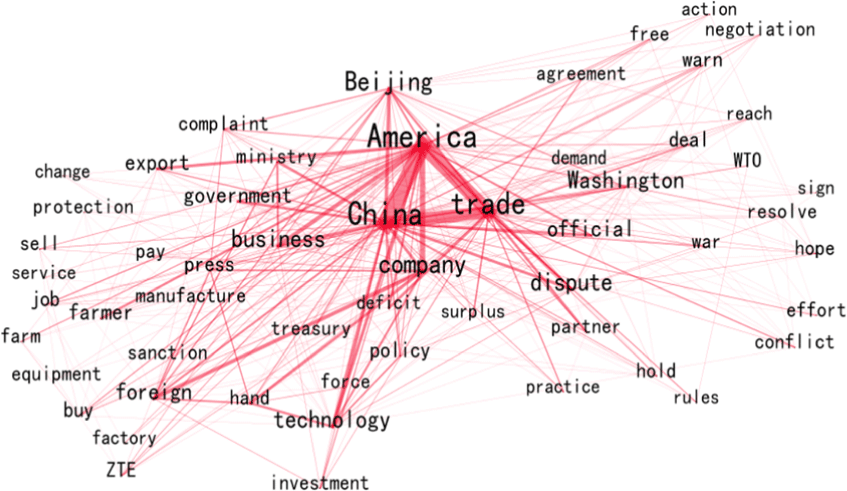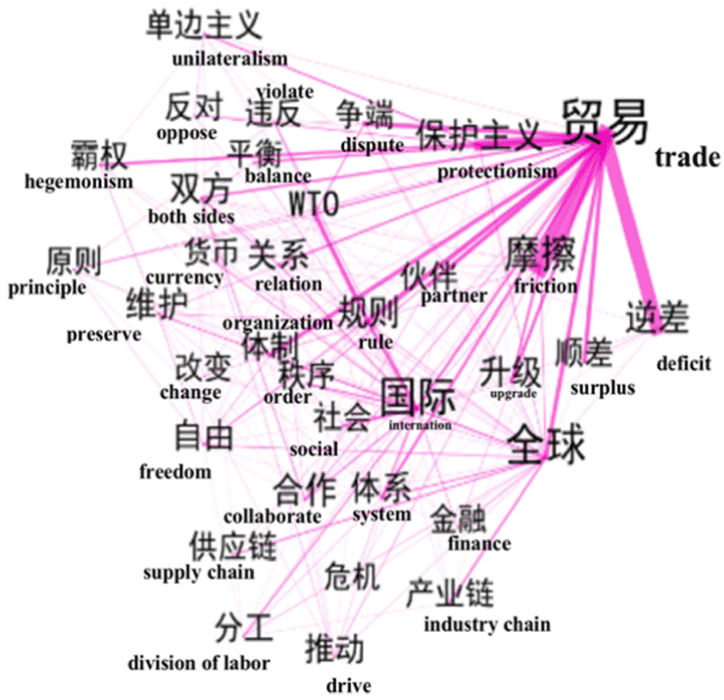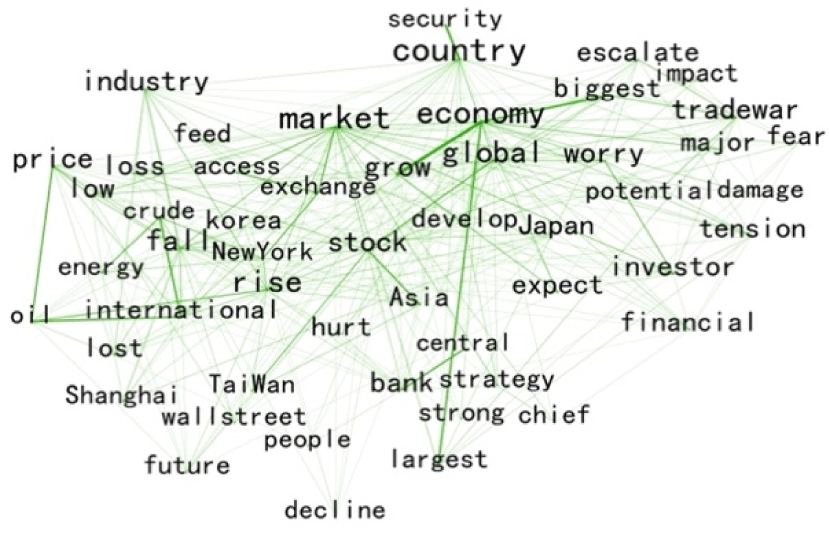I. INTRODUCTION
Walter Lippmann, the intellectual father of agenda-setting theory, contended that the news media construct a pseudo-environment for the public bridging the world outside and pictures in our heads [1]. In 1993, New Zealand scholar Howard Frederick proposed global journalism and global communication. Across the global landscape, our knowledge is still very limited about the similarity of media agendas.
The focus of the research is the Sino-US trade, which is a lengthy and highly controversial international and domestic issue. The complexity of Sino-US trade news, and the mix of international politics and economics, among other aspects, makes it a rich setting for using this new, networked agenda-setting perspective to explore how the news media in different countries sportrayed the same international event. The purpose of this study is to analyze the similarities and differences of semantic networks of news reports constructed by government journalists with different political positions on Sino-US trade issues. To what extent are these attribute networks similar, reflecting global journalism and global communication? To what extent do these attribute networks differ, reflecting the diverse political stances and cultures of the United States and China?
II. THE THEORETICAL FRAMEWORK
The traditional theory of agenda setting mainly includes object agenda setting and attribute agenda setting, that is, the first level and the second level of agenda setting. Communication scholars Maxwell McCo-mbs and Donald Shaw published the article “The Agenda Setting Function of Mass Communication” to formally put forward the theory of agenda setting [2]. The core idea of agenda-setting theory is that the Salience of issues emphasized by the media can be transferred to the public agenda [3].
The second level of agenda-setting theory elaborates on the connection between the details of the topic in the news and the "picture in our mind", namely the attribute agenda-setting effect [4]. Based on cognitive network theory and social network analysis research methods, McCombs and Guo Lei proposed the third level of agenda-setting theory, Networked Agenda Setting (NAS theory for short), the core theory holds that the way the news media connects different information, concepts, and ideas can affect the audience’s way of connecting different information, concepts, and ideas. At the same time, what affects the public is not a single issue or attribute, but a cognitive network composed of a series of issues. The Network Agenda Setting (NAS) model focuses on an integrated network agenda [5].
Specifically, the NAS model proposes that the salience of networked relationships among objects and/or attributes can be transferred between the media and public agendas as well as between different media agendas. In other words, news media can tell us how to link these objects and attributes with one another. At present, agenda setting is widely used to compare the correlation between media and public agenda setting. Scholars have further confirmed the theory of network agenda setting through comparative analysis of the correlation between media reports and public agenda setting. Guo et al. (2015) used the theory of network agenda setting to compare the agenda setting among media at the network level of newspapers under different cultural and political backgrounds [6]. At present, there are few comparative studies between countries in agenda-setting research.
Dutch psychologist Geert Hofstede's cultural value dimension theory is a framework for cross-cultural research. In 1980, Hofstede published the masterpiece “Cultural Influence: A Cross-Country Comparison of Values, Behaviors, Systems, and Organizations”, and later adopted the supplements to his theory by Penmack and other scholars, summing up the five dimensions of measuring values: individualism versus collectivism, uncertainty avoidance, power distance, masculinity, versus femininity, long-term versus short-term orientation.
The dimensions of individualism and collectivism measure whether a society is concerned with the interests of the individual or the interests of the group. According to Hofstede's research, societies with high levels of individualistic cultures are more “I” focused, focus on personal goals, and are less dependent on organizations or institutions. The cultural dimension of collectivism emphasizes “we”, and people depend on the organization or team they belong to.
The uncertainty avoidance index refers to whether a society uses formal channels to avoid and control uncertainty when it is threatened by uncertain events and unconventional environments. According to Hofstede's research, countries with a high uncertainty index generally provide members with stability, establish more formal rules, and seek consensus. People from countries with low certainty are more likely to accept uncertainty in life. Power distance refers to the degree to which people with low status in a society accept the unequal distribution of power in a society or organization [7].
Hofstede’s theory has always been one of the main tools for scholars to conduct cross-cultural research. In the field of news communication, starting from the cultural point of view, it is mainly to use Hofstede's cultural theory to compare and analyze the differences in the reports of the same topic in different countries’ media.
There are two different perspectives on how journalists in different countries cover the same international issues. Scholars working on Transnational Media Studies present conflicting views on how journalists from different countries report the same international issues [3]. Based on the perspective of the globalization of journalism, researchers believed that news reports tend to be globalized [8-9]. Some researchers believed that news reports based on different countries and regions may be significantly different due to cultural differrences and the government's political stance on a certain issue [10-11]. This study conducts a comprehensive content analysis of the news coverage on Sino-US trade in both countries to examine the extent to which the coverage is similar in its global perspective and extent to which the coverage reflects significant differences in the cultural and political positions of the two countries.
III. RESEARCH QUESTIONS AND METHOD
This study uses the semantic network to analyze how Chinese and American newspapers construct Sino-US trade reports. We begin with a hypothesis where the projection of intermedia networked agenda setting to an international setting intersects with the perspectives of journalism scholars who see the emergence of highly homogeneous global journalism.
H1: The networked attribute agendas of the Sino-US trade in the coverages of China and the United States will be positively correlated.
Since news reports in China and the United States may differ due to cultural differences and differences in the government’s political stance on Sino-US trade frictions, there will be a low degree of correspondence between the online agendas of the two media’s news reports, namely:
H2: The networked attribute agendas of the Sino-US trade in the coverages of China and the United States will correspond to a moderate to low degree.
In order to further explore the issue of Sino-US trade between China and the United States may be different in the reports due to cultural differences and government political stances, this study proposes a research question:
Q1: From the distribution of topics, what are the characteristics of Xinhua News Agency and the Associated Press's news reports on Sino-US trade?
In addition to the differences in political interests, political environment, and market systems of different countries, cultural factors are also the key factors for scholars to discuss. Therefore, the differences in cultural concepts and values between China and the United States are the inherent root of Sino-US trade frictions.
Based on the cultural value dimension theory of Geert Hofstede, this study explores the differences between China and the United States in the reports on Sino-US trade frictions that may be caused by cultural differences and different political positions of the government from a micro level, namely:
On March 22, 2018, US President Trump signed a decision to impose tariffs on Chinese exports to the United States at the White House. The next day, China's Ministry of Commerce issued a targeted response, marking the official start of Sino-US trade friction. This incident has attracted much attention and has been widely reported by news media from all over the world. The content analysis of the Sino-US trade coverage included two news agencies: Associated Press from the United States and Xinhua News Agency from China.
The time frame of the content analysis was March 20, 2018, to October 31, 2018. Four search terms, “trade dispute”, “trade conflict”, “trade friction” or “trade war” were used to retrieve the news articles.
By checking the collected reports one by one and selecting the news reports with the theme of Sino-US trade friction, we finally got 207 reports from Xinhua News Agency and 261 articles from Associated Press, respectively constructing Xinhua News Agency (N=207) and Associated Press (N=261) corpus.
This study used the NLPIR Chinese word segmentation system (ICTCLAS 2014) and the Python to perform Chinese word segmentation on the Xinhua News Agency corpus. Based on the first word segmentation, a new “user dictionary” was added to form a user-defined dictionary. Due to the limitation of the dictionary, after the first word segmentation, some fixed words could not be recognized, for example, “Trump”, “trade”, “friction”, “protectionism”, “unilateralism”, etc., were divided into independent words. Therefore, artificially screened the initially generated word segmentation text multiple times, corrected the unreasonable word segmentation processing, and finally gated a reasonable and correct word segmentation text.
The research defined the co-occurrence analysis unit as a news report, counted two words that appeared in each news report as co-occurrence, and counted the frequency of co-occurrence of words in the Xinhua News Agency and the Associated Press data respectively, and built semantic networks separately. In this study, a visual open-source software Gephi was used to visualize the network diagrams of Xinhua News Agency and Associated Press, statistical analysis and modular calculation. The eigenvector centralities of each word were analyzed statistically by Gephi. The size of the word label depended on the size of the degree of the word. Links indicated co-occurrences between words, and the more co-occurrences between two words, the thicker the link. In agenda-setting theory, the word concentration is a better measure of word salience than word frequency. The feature vector represents the concentration of a word in the overall network, that is, if a word relates to more core words, then the feature vector of the word will increase accordingly [12].
The study used the Quadratic Assignment Procedure (QAP) to test H1 and H2 that consider the degree of similarity or dissimilarity among the two news organizations’ network attributes agendas. Quadratic Assignment Procedure (QAP) is a statistical tool that calculates the correlations among the two attribute networks. Ucinet software was used to calculate QAP correlation (Quadrastic Assignment Procedure, QAP) for hypothesis testing. QAP correlation analysis is a method for comparing the similarity of each grid value in two square matrices, which is used to test correlation between networks. In order to test H1 and H2 that consider the degree of similarity or dissimilarity among the two news organizations network attributes agendas, we used the Quadratic Assignment Procedure (QAP), a statistical tool that compares matrices, to calculate the correlations among the two attribute networks. Ucinet software was used to calculate QAP correlation for hypothesis testing. QAP correlation analysis is a method for comparing the similarity of each grid value in two square matrices, which is used to test the correlation between networks.
In order to answer RQ1, this study used Gephi software to conduct statistical analysis and modular calculations on the reporting network of Xinhua News Agency and the Associated Press respectively and examined the cluster distribution characteristics presented by Xinhua News Agency and Associated Press from a more intuitive perspective.
IV. RESULTS
This study used the social network analysis tool Ucinet to test the research hypothesis. In order to maintain a clear presentation of the semantic network and deeply analyze the similarities and differences between the semantic networks, this study selected the 150 most frequent words as the analysis object. Among the 150 high-frequency words, 69 words co-occur in the two networks of Xinhua News Agency and Associated Press, accounting for 46% of the overall network structure (150 words) (Table 1).
Turning to the differences among the newspapers predicted by H1 and H2, there are statistically significant low correlations between the networked agendas of the Xinhua News Agency and Associated Press (Xinhua News Agency-Associated Press, +0.337, p<0.001). Xinhua News Agency and the Associated Press showed a moderate correlation when reporting Sino-US trade frictions. Therefore, H1 and H2 were supported.
In this study, Gephi software was used to conduct statistical analysis and modular calculation on the reporting networks of Xinhua News Agency and Associated Press respectively. Xinhua News Agency had 4 clusters after modular processing, and Associated Press had 3 clusters after modular processing. In Fig. 1 and Fig. 2, different color regions represented different clusters of the semantic network.
For Q1, Table 2 illustrated the cluster distribution of semantic networks in Xinhua News Agency and Associated Press reports on Sino-US trade friction. The table included the most concentrated five words in each cluster and the feature vector of each word in the overall network. The percentage represented the percentage of words contained in each cluster in the overall semantic network (150 words).
Xinhua News Agency involved four sub-topics when reporting Sino-US trade frictions, namely China related clusters (China, 0.99; Enterprise, 0.82; Market, 0.80; Product, 0.67; Import, 0.62), US-related clusters (United States, 1.00; Economy, 0.88; Trade friction, 0.74; Government, 0.73; Impact, 0.68), trade-related clusters (Trade, 0.99; Globally, 0.80; International, 0.71; Friction, 0.60; deficit, 0.46), and tariff-related clusters (Tariff, 0.75; Additional tariff, 0.47; Cause, 0.47; Harm, 0.24; Rise, 0.18). The Associated Press involved three sub-topics, namely China-US Trade-related clusters (America, 1.00; China, 0.99; Trade, 0.93; Beijing, 0.71; Company,0.70), global economy-related clusters (Country, 0.69; Market, 0.66; Economy, 0.63; Rise, 0.50; Global, 0.46), tariff-related clusters (tariff, 0.85; Trump, 0.80; president, 0.61; import, 0.56; threat, 0.53). Xinhua News Agency focused on China-related clusters, accounting for 37.33%, while Associated Press focused on Sino-US trade-related clusters, accounting for 37.33%.
At the same time, from the most concentrated top five salient words in each cluster in Table 2, it could be seen that Xinhua News Agency and Associated Press had different emphases in the prominence process of words. This fully demonstrated that the global dissemination of Xinhua News Agency and the Associated Press on the topic of Sino-US trade frictions had not achieved the goal of value neutrality but reflected a clear difference in reporting.
For Q2, Gephi was used to measure the feature vectors of words in the two overall networks, and after sorting them in descending order, the top 10 were selected for comparative analysis. From the perspective of multiculturalism and political stance, Xinhua News Agency and the Associated Press had obvious differences in their strategies for constructing frameworks when reporting on Sino-US trade frictions.
In the Xinhua News Agency Semantic Network, as shown in Fig. 3, among the red clusters related to China, the most closely connected words were high-frequency words that highlighted trade, such as “China”, “import”, “export”, “enterprise”, “product”, and “market”.
In the green clusters related to the United States in Fig. 4, the high-frequency words were more consentrated in the relevant groups affected by the Sino-US trade friction, such as “farmers”, “people”, “consumers”, “industry”, “industry”, “agriculture”, “manufacturing”, “agricultural products”, “automobiles”, “ZTE”, “stock market”, “income”, “employment”, etc.
The Associated Press reported on the sub-topics presented after the modularization of the network, concentrating China, the United States and trade in one cluster, and the high-frequency words included “company”, “business”, “manufacture”, “factory”, “farm”, “ZTE”, “technology”, “investment”, “farmer”, “job” (Fig. 5).
In the Xinhua News Agency network, trade-related clusters included high-frequency words such as “crisis”, “unilateralism”, “protectionism”, “hegemony”, and “violation”, highlighting the motives and impacts of trade frictions. At the same time, Xinhua News Agency's semantic reporting network mainly used high frequency words such as "freedom”, “rules”, “both parties”, “cooperation”, “balance”, and “system” to build a framework for resolving trade frictions. In the semantic network of Xinhua News Agency, the cultural value dimension of collectivism is more prominent, for example, high-frequency words such as “both sides”, “relationship”, “cooperation”, and “partner” (Fig. 6).
In the Semantic Network of the Associated Press, words, such as “market”, “economy”, “global”, and “international”, highlighted the global perspective. Words, such as “rise”, “fall”, “grow”, “loss”, “low”, “escalate”, “investor”, “hurt”, “security”, “damage”, “decline”, and “industry”, “stock”, “Price”, “investor”, “bank”, “financial” and other high-frequency words highlighted the impact of trade frictions (Fig. 7).
From the perspective of culture, Hofstede's value dimension of individualism and collectivism points out that a society with a high level of individualism culture pays more attention to “I”, while the cultural dimension of collectivism emphasizes “we”. In the semantic network of Xinhua News Agency, the cultural value dimension of Chinese collectivism is highlighted. For example, high-frequency words such as “both sides”, “relationship”, “cooperation” and “partner” (Fig. 6).
According to Hofstede's uncertainty avoidance Index, which ranges from 0 to 100, a high score for a country indicates that its members cannot withstand the lowest uncertainty index. The uncertainty index in China is close to 60, indicating that Chinese people are more inclined to reduce the occurrence of unknown and uncertain situations, and more inclined to make gradual and cautious changes through plans, rules, laws, and regulations. In the trade cluster of Xinhua News Agency, high-frequency words such as “system”, “order”, “system” and “principle” better highlight this value dimension.
V. CONCLUSION AND LIMITATIONS
This study examined how US and Chinese newspapers cover the topic of the Sino-US trade from the perspective of Internet agenda setting. This study examined intermedia agenda setting at the network level through a comparison of newspapers situated in diverse cultures and political settings. The networked attribute agendas of the Sino-US trade in the newspapers of the United States and China tilt toward heterogeneity. Although the correlations are positive and significant, +0.337, the values are low.
From the perspective of multiculturalism and political standpoints, Xinhua News Agency and the Associated Press report on Sino-US trade frictions had obvious differences in framing strategies. After modular processing, Xinhua News Agency involved four sub-topics when reporting Sino-US trade frictions, namely China-related clusters, US-related clusters, trade-related clusters, and tariff-related clusters; the Associated Press involved three sub-topics, clusters related to Sino-US trade, clusters related to the global economy, and clusters related to tariffs.
This study has several limitations. First, these analyses of the news are based on limited geography. This may reduce the generalizability of our results. Future researchers could try to explore more comparisons between different countries’ reports on Sino-US trade. Second, future research may expand to different media channels in various regions to see whether the distinction still exists. Research should focus more on agenda-setting on the US-China trade on social media. The agenda-setting effect still exists on social media, and future studies can analyze and compare the differences in the agenda-setting of Sino-US trade reports on social media in different countries. Future research could also investigate the role of hashtags used on social media to discuss the US-China trade agenda and the impact of that agenda on public opinion.








